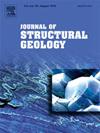Unraveling progressive stages of formation and examining relative roles of proximity to fault, mechanical stratigraphy on fracturing in the leading-edge of thrust sheets: Insights from Ramgarh thrust, Darjeeling Himalaya
IF 2.9
2区 地球科学
Q2 GEOSCIENCES, MULTIDISCIPLINARY
引用次数: 0
Abstract
We decipher the progressive stages of fracture formation and examine the competing effects of proximity to a thrust, lithology, and bed thickness on fracture abundance, orientation, mode, and length. We address this study in the interfoliated quartzite-phyllite sequence of the leading-edge (∼3.4 km) of the Ramgarh thrust (RT) sheet, the roof thrust of the lower Lesser Himalayan duplex in the Darjeeling Himalaya. Only ∼30 % of the total studied fractures (n = 884) preserve slickenlines and plumose structures. Due to favorable orientations relative to the vertical outcrop bearing, small displacement faults (shear fractures) (n = 236; ∼27 % of total fractures) with slickenlines are better exposed than opening-mode (n = 32; ∼4 %) with plumose structures. Further structural analyses reveal coexisting shear (∼59 %) and opening-mode (∼41 %) fractures. Through crosscutting, fold test, and intensity distribution, we establish fracturing initiated with low-angle, shear fractures during early layer parallel shortening. High-angle, shear, and opening-mode fractures formed post-folding. Fracture density fluctuates with perpendicular distance from the footwall contact due to variation in lithology and bed thickness. Fracture density most strongly depends on lithology (quartzitefractures > phyllitefractures), followed by bed thickness (thin bedsfractures > thick bedsfractures) and distance from the RT. Fracture mode and orientation, with respect to bedding, are similar across lithologies, only intensity differs. High-angle and Riedel shear fractures are localized proximal to the RT. Shear vs opening-mode proportions remain unchanged with increasing distance from the RT. Litho-boundaries and early-formed fractures constrain fracture lengths (ntraces = 10,758), irrespective of their mode and orientation. Fracture networks show more evolved length distributions close to the RT.
揭示形成的渐进阶段,研究断层附近的相对作用,机械地层学对逆冲片前缘破裂的影响:来自大吉岭-喜马拉雅拉姆加尔逆冲断层的见解
我们破译了裂缝形成的渐进阶段,并研究了与冲断的接近程度、岩性和层厚对裂缝丰度、方向、模式和长度的竞争影响。我们在Ramgarh逆冲(RT)薄片前缘(~ 3.4 km)的夹层石英岩-千层岩层序中进行了这项研究,该逆冲是大吉岭-喜马拉雅下部小喜马拉雅双相的顶板逆冲。在研究的所有裂缝中,只有约30% (n = 884)保留了丝状线和羽状结构。由于相对于垂直露头方位有利,小位移断层(剪切裂缝)(n = 236;约占总裂缝的27%)与开放模式相比,滑膜线的暴露效果更好(n = 32;~ 4%)具有羽状结构。进一步的结构分析显示,剪切裂缝(约59%)和张开型裂缝(约41%)并存。通过横切、褶皱试验和强度分布,确定了地层平行缩短早期以低角度剪切裂缝起裂。褶皱后形成高角度、剪切和开敞型裂缝。由于岩性和层厚的变化,裂缝密度随与下盘接触的垂直距离而波动。裂缝密度主要取决于岩性(石英岩裂缝);千层裂缝),其次是层厚(薄层裂缝);裂缝的模式和方向,就层理而言,在岩性上是相似的,只是强度不同。高角剪切裂缝和Riedel剪切裂缝位于rt附近。随着距离rt的增加,剪切模式与打开模式的比例保持不变。无论其模式和方向如何,岩石边界和早期形成的裂缝都约束着裂缝长度(ntraces = 10758)。裂缝网络的长度分布更接近RT。
本文章由计算机程序翻译,如有差异,请以英文原文为准。
求助全文
约1分钟内获得全文
求助全文
来源期刊

Journal of Structural Geology
地学-地球科学综合
CiteScore
6.00
自引率
19.40%
发文量
192
审稿时长
15.7 weeks
期刊介绍:
The Journal of Structural Geology publishes process-oriented investigations about structural geology using appropriate combinations of analog and digital field data, seismic reflection data, satellite-derived data, geometric analysis, kinematic analysis, laboratory experiments, computer visualizations, and analogue or numerical modelling on all scales. Contributions are encouraged to draw perspectives from rheology, rock mechanics, geophysics,metamorphism, sedimentology, petroleum geology, economic geology, geodynamics, planetary geology, tectonics and neotectonics to provide a more powerful understanding of deformation processes and systems. Given the visual nature of the discipline, supplementary materials that portray the data and analysis in 3-D or quasi 3-D manners, including the use of videos, and/or graphical abstracts can significantly strengthen the impact of contributions.
 求助内容:
求助内容: 应助结果提醒方式:
应助结果提醒方式:


